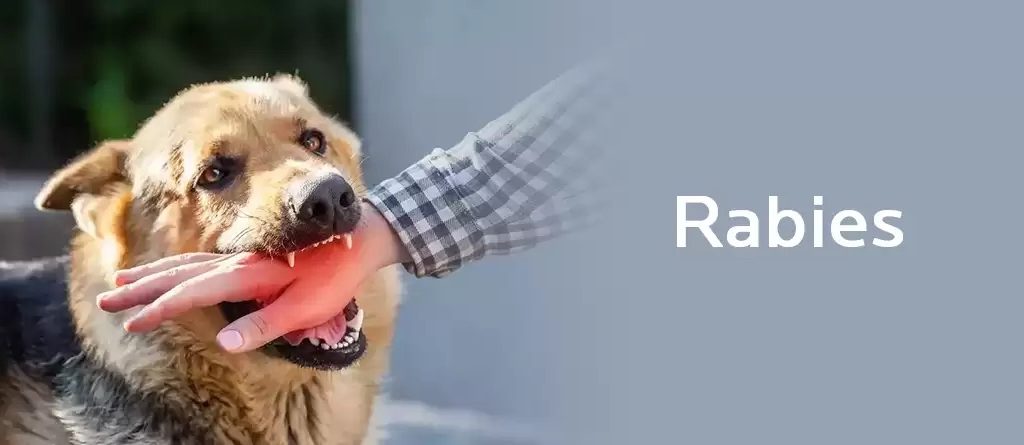
Interesting facts about Rabies
- About 59000 human deaths occur every year across the world due to rabies.
- All warm-blooded mammals are susceptible to infection by the rabies virus.
- Rabies is a disease with the highest documented case-fatality rate close to 100%.
- Almost 50000 people seek post-exposure prophylaxis in Nepal based on the available medical records.
- Global framework for the elimination of dog-mediated human rabies, outlining the commitment and actions required to achieve a common goal of zero human rabies deaths by 2030, worldwide.
INTRODUCTION
Rabies virus belongs to genus Lyssavirus in the family Rhabdoviridae. It is single stranded enveloped RNA virus.
Rabies is transmitted through direct contact between the virus(e.g. in contaminated saliva), and mucous membranes or wounds. Human infection most frequently occurs following a transdermal bite or scratch from an infected animal. Human-human transmission has never been confirmed with the exception of organ transplants from rapid patients.
The consequence of an exposure to rabies virus depends on the several factors including:
- The severity of the wound.
- The location of the bite on the body.
- The quantity of virus inoculated into the wounds.
- The timelines of post-exposure prophylaxis(PEP).
Human rabies can manifest clinically as either :
1. Furious form(Classical)
2. Paralytic form
The clinical presentation includes:
| Furious Rabies (Classical) | Paralytic Rabies |
| • Hydrophobia • Aerophobia and Photophobia • Excitation and confusion • Excessive sweating and salivation • Dehydration • Death in 2-5 days | • Gradual ascending paralysis • Hydrophobia is not seen • Myoedema and piloerection • Stupor, Coma • May resemble Guillain–Barré syndrome • Death in 1-2 weeks |
WHO Classification of Exposures
| CATEGORY OF EXPOSURE | TYPE OF CONTACT |
| Category I | • Touching or feeding of animals • Animal licks on intact skin (NO EXPOSURE) |
| Category II | • Nibbling of uncovered skin • Minor scratches or abrasions without bleeding (EXPOSURE) |
| Category III | • Single or multiple trans dermal bites or scratches • Contamination of mucous membrane or broken skin with saliva from animal licks • (Exposures due to direct contact with bats*) (SEVERE EXPOSURE) |
PEP by category of exposure :
| Category I Exposure | Category II Exposure | Category III Exposure | |
| Immunologically naive individuals of all age groups | No PEP required | Wound washing and Immediate vaccination | Wound washing and Immediate vaccination and RIG administration |
How to wash the wounds after the bite?
-The wounds should be washed with soap water for about 15 minutes continuously and if the soap isn’t available then continuously flowing water should be rinsed through the wound.
-Application of local remedies on the wound should be strongly discouraged.
-Local antiseptic agent should be applied (Povidone Iodine) on the wound.
How to administer Rabies Vaccine?
0.1ml of reconstituted vaccine is administered per ID site. 0.1ml. is injected into the upper layer of the skin over the deltoid area of one arm. Similarly, 0.1ml. is injected in the other arm. The WHO approved regimen for intradermal route is 1 week, 2 site regimen on 0,3,7 days.
How to administer Rabies immunoglobulin?
The role of RIG in passive immunization is to provide neutralizing antibodies at the site of exposure before patients start producing their own antibodies as a result of vaccination. RIG has the property of neutralization of the rabies virus, and hence it is appropriate to infiltrate RIG locally at the site of exposure.
RIG is administered only once, preferably at or as soon as possible after initiation of post-exposure vaccination. Rabies immunoglobulin should be given with the first dose of vaccine into and around the wound site. It is not indicated beyond the seventh day after the first dose of rabies vaccine, (regardless of whether the doses were received on days 3 or 7) because an active antibody response to the rabies vaccine would have already started, and administration of RIG at this stage can suppress the immune response of the patient to the Rabies Vaccine received.
The maximum dose of
• Human RIG -20 IU/kg of body weight
• Equine immunoglobulin and F(ab’)2 products- 40 IU/kg of body weight
Can we suture the wound after the bite?
– Suturing of the wound should be strictly avoided.
BUT
If suturing is unavoidable (as in lacerated wounds), Rabies Immunoglobulins should be first infiltrated into the wounds and suturing should be delayed by a few hours to allow diffusion of the immunoglobulins into the tissues. Later, minimum number of sutures should be applied. For cosmetic purposes, secondary sutures can be done two weeks after initiating vaccination.
Whenever necessary, Tetanus prophylaxis should be instituted. Tetanus Toxoid (0.5ml IM) can be given. Antibiotics may be recommended, if needed.
What, if there is Re Exposure???
PEP for re exposure cases based on category of exposure:
| Category I Exposure | Category II Exposure | Category III Exposure | |
| Previously immunized individuals of all age groups | No PEP required | Wound washing and Immediate vaccination RIG is not indicated | Wound washing and Immediate vaccination RIG is not indicated |
Do we need vaccination again, after the re exposure?
-If an individual has a repeat exposure less than 3 month after a previous exposure, and has already received a complete PEP, only wound treatment is required; neither vaccine nor RIG is needed.
Persons who cannot document previous pre or post-exposure prophylaxis, should be treated as a fresh case and given complete PEP.
0.1ml intra dermal injection should be given on days 0 and 3 days on single site on deltoid/lateral aspect of thigh.
According to National Guideline of Rabies prophylaxis in NEPAL
Is it necessary to administer vaccine in the following cases?
-Bite by rodents
RABV infection in rodents is very uncommon. No human rabies cases due to bites by rodents have been reported. Exposure to domestic rodents, squirrel, hare and rabbits do not routinely require PEP.
-Observation of biting animal
The observation period of 10 days is valid for dogs and cats only. A dog or cat suffering from Rabies will die within a period of 10 days after the clinical symptoms are seen in the dog/cat. The natural history of rabies in mammals other than dogs and cats is not fully understood and therefore the 10-day observation period is not applicable to other animals.
PEP should be started immediately after the exposure, even if it is due to a dog or cat. With the latest WHO protocol, treatment by ID route ends by day 7.
-Vaccination status of the biting animal
A history of rabies vaccination in an animal is not always a guarantee that the biting animal is not rabid. Vaccine failures may occur because of improper administration or improper storage of the vaccine, poor health status of the animal, and the fact that one vaccine dose does not always provide long-lasting protection against rabies infection in dogs.
-Provoked versus unprovoked bites
PEP should be immediately instituted irrespective of whether the bite was provoked or unprovoked.
-Bite by wild animals
Bite by all wild animals should be treated as Category III exposure.
-Consumption of raw meat or milk from a rabid animal
No case of human rabies resulting from consumption of raw meat or milk from a rabid animal has been documented. PEP is not required in persons consuming milk of a rabid animal.
Human-to-human transmission
The only documented cases of human-to-human transmission occurred via tissue and organ transplants from RABV-infected individuals, and a single case of likely perinatal RABV transmission via transplant was reported.
Caution should be exercised before transplanting organs from people who have died with neurological symptoms.
Individuals who had symptoms of encephalitis before death should be excluded from organ donation unless rabies can be excluded out as a cause of the encephalitis. People who have been exposed closely to the secretions of a patient with rabies may be offered PEP as a precautionary measure.
The risk of an infant contracting rabies from breast milk is similar to that of drinking milk from a rabid animal: it does not pose a risk to the infant.
#Pregnant and lactating women
Rabies vaccine and RIG can be administered safely to pregnant and lactating women. PEP should never be withheld from pregnant or lactating women.
Pre Exposure prophylaxis to high risk population
High risk population includes:
-Occupational workers particularly animal related.
-Health care worker involved in care of patient with rabies
-Traveller’s who may be at risk of exposure
| Dose | Route | Duration | No of Injection Sites Per Clinic Visit | Sites |
| 0.1ml Each site | Intradermal | 2 visits (1 week) • Day 0 • Day 7 | 2 sites 2-0-2-0-0 | • Deltoid OR • Lateral thigh |



